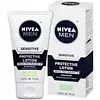What's inside
What's inside
 Key Ingredients
Key Ingredients

 Benefits
Benefits

 Concerns
Concerns

 Ingredients Side-by-side
Ingredients Side-by-side

Water
Skin ConditioningDicaprylyl Carbonate
EmollientGlycerin
HumectantNiacinamide
SmoothingPropanediol
SolventBetaine
HumectantPolyglyceryl-4 Isostearate
EmulsifyingCoco-Caprylate/Caprate
EmollientMagnesium Sulfate
Glycosphingolipids
EmollientGlycolipids
Skin ConditioningSodium Benzoate
MaskingDisteardimonium Hectorite
StabilisingOleic Acid
EmollientPotassium Sorbate
PreservativeCitric Acid
BufferingPolyglycerin-3
HumectantButyl Methoxydibenzoylmethane 3%
UV AbsorberEthylhexyl Salicylate 4.7%
UV AbsorberOctocrylene 8.4%
UV AbsorberWater
Skin ConditioningIsopropyl Palmitate
EmollientGlycerin
HumectantTapioca Starch
Cetearyl Alcohol
EmollientGlyceryl Stearate Citrate
EmollientTocopheryl Acetate
AntioxidantPanthenol
Skin ConditioningChamomilla Recutita Flower Extract
MaskingHamamelis Virginiana Bark/Leaf Extract
Astringent1,2-Hexanediol
Skin ConditioningCarbomer
Emulsion StabilisingEthylhexylglycerin
Skin ConditioningMaltodextrin
AbsorbentCaprylic/Capric Triglyceride
MaskingAcrylates/C10-30 Alkyl Acrylate Crosspolymer
Emulsion StabilisingSodium Hydroxide
BufferingTrisodium EDTA
Phenoxyethanol
PreservativePiroctone Olamine
PreservativeParfum
MaskingButyl Methoxydibenzoylmethane 3%, Ethylhexyl Salicylate 4.7%, Octocrylene 8.4%, Water, Isopropyl Palmitate, Glycerin, Tapioca Starch, Cetearyl Alcohol, Glyceryl Stearate Citrate, Tocopheryl Acetate, Panthenol, Chamomilla Recutita Flower Extract, Hamamelis Virginiana Bark/Leaf Extract, 1,2-Hexanediol, Carbomer, Ethylhexylglycerin, Maltodextrin, Caprylic/Capric Triglyceride, Acrylates/C10-30 Alkyl Acrylate Crosspolymer, Sodium Hydroxide, Trisodium EDTA, Phenoxyethanol, Piroctone Olamine, Parfum
 Reviews
Reviews

Ingredients Explained
These ingredients are found in both products.
Ingredients higher up in an ingredient list are typically present in a larger amount.
Glycerin is already naturally found in your skin. It helps moisturize and protect your skin.
A study from 2016 found glycerin to be more effective as a humectant than AHAs and hyaluronic acid.
As a humectant, it helps the skin stay hydrated by pulling moisture to your skin. The low molecular weight of glycerin allows it to pull moisture into the deeper layers of your skin.
Hydrated skin improves your skin barrier; Your skin barrier helps protect against irritants and bacteria.
Glycerin has also been found to have antimicrobial and antiviral properties. Due to these properties, glycerin is often used in wound and burn treatments.
In cosmetics, glycerin is usually derived from plants such as soybean or palm. However, it can also be sourced from animals, such as tallow or animal fat.
This ingredient is organic, colorless, odorless, and non-toxic.
Glycerin is the name for this ingredient in American English. British English uses Glycerol/Glycerine.
Learn more about GlycerinWater. It's the most common cosmetic ingredient of all. You'll usually see it at the top of ingredient lists, meaning that it makes up the largest part of the product.
So why is it so popular? Water most often acts as a solvent - this means that it helps dissolve other ingredients into the formulation.
You'll also recognize water as that liquid we all need to stay alive. If you see this, drink a glass of water. Stay hydrated!
Learn more about Water